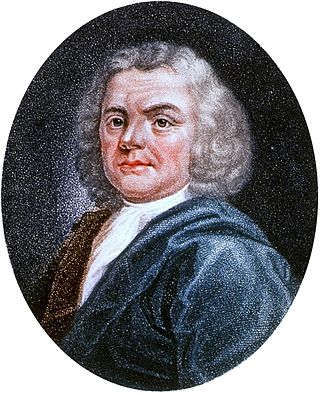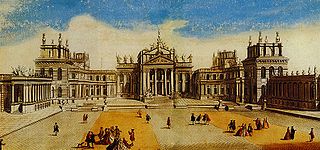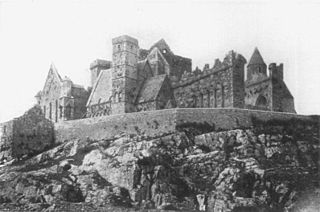Related Research Articles

Herman Boerhaave was a Dutch botanist, chemist, Christian humanist, and physician of European fame. He is regarded as the founder of clinical teaching and of the modern academic hospital and is sometimes referred to as "the father of physiology," along with Venetian physician Santorio Santorio (1561–1636). Boerhaave introduced the quantitative approach into medicine, along with his pupil Albrecht von Haller (1708–1777) and is best known for demonstrating the relation of symptoms to lesions. He was the first to isolate the chemical urea from urine. He was the first physician to put thermometer measurements to clinical practice. His motto was Simplex sigillum veri: 'Simplicity is the sign of the truth'. He is often hailed as the "Dutch Hippocrates".

1691 (MDCXCI) was a common year starting on Monday of the Gregorian calendar and a common year starting on Thursday of the Julian calendar, the 1691st year of the Common Era (CE) and Anno Domini (AD) designations, the 691st year of the 2nd millennium, the 91st year of the 17th century, and the 2nd year of the 1690s decade. As of the start of 1691, the Gregorian calendar was 10 days ahead of the Julian calendar, which remained in localized use until 1923.

1695 (MDCXCV) was a common year starting on Saturday of the Gregorian calendar and a common year starting on Tuesday of the Julian calendar, the 1695th year of the Common Era (CE) and Anno Domini (AD) designations, the 695th year of the 2nd millennium, the 95th year of the 17th century, and the 6th year of the 1690s decade. As of the start of 1695, the Gregorian calendar was 10 days ahead of the Julian calendar, which remained in localized use until 1923.
The 1710s decade ran from January 1, 1710 to December 31, 1719.

1793 (MDCCXCIII) was a common year starting on Tuesday of the Gregorian calendar and a common year starting on Saturday of the Julian calendar, the 1793rd year of the Common Era (CE) and Anno Domini (AD) designations, the 793rd year of the 2nd millennium, the 93rd year of the 18th century, and the 4th year of the 1790s decade. As of the start of 1793, the Gregorian calendar was 11 days ahead of the Julian calendar, which remained in localized use until 1923.

1724 (MDCCXXIV) was a leap year starting on Saturday of the Gregorian calendar and a leap year starting on Wednesday of the Julian calendar, the 1724th year of the Common Era (CE) and Anno Domini (AD) designations, the 724th year of the 2nd millennium, the 24th year of the 18th century, and the 5th year of the 1720s decade. As of the start of 1724, the Gregorian calendar was 11 days ahead of the Julian calendar, which remained in localized use until 1923.

1647 (MDCXLVII) was a common year starting on Tuesday of the Gregorian calendar and a common year starting on Friday of the Julian calendar, the 1647th year of the Common Era (CE) and Anno Domini (AD) designations, the 647th year of the 2nd millennium, the 47th year of the 17th century, and the 8th year of the 1640s decade. As of the start of 1647, the Gregorian calendar was 10 days ahead of the Julian calendar, which remained in localized use until 1923.

1717 (MDCCXVII) was a common year starting on Friday of the Gregorian calendar and a common year starting on Tuesday of the Julian calendar, the 1717th year of the Common Era (CE) and Anno Domini (AD) designations, the 717th year of the 2nd millennium, the 17th year of the 18th century, and the 8th year of the 1710s decade. As of the start of 1717, the Gregorian calendar was 11 days ahead of the Julian calendar, which remained in localized use until 1923.

1719 (MDCCXIX) was a common year starting on Sunday of the Gregorian calendar and a common year starting on Thursday of the Julian calendar, the 1719th year of the Common Era (CE) and Anno Domini (AD) designations, the 719th year of the 2nd millennium, the 19th year of the 18th century, and the 10th and last year of the 1710s decade. As of the start of 1719, the Gregorian calendar was 11 days ahead of the Julian calendar, which remained in localized use until 1923.

1702 (MDCCII) was a common year starting on Sunday of the Gregorian calendar and a common year starting on Thursday of the Julian calendar, the 1702nd year of the Common Era (CE) and Anno Domini (AD) designations, the 702nd year of the 2nd millennium, the 2nd year of the 18th century, and the 3rd year of the 1700s decade. As of the start of 1702, the Gregorian calendar was 11 days ahead of the Julian calendar, which remained in localized use until 1923.
1704 (MDCCIV) was a leap year starting on Tuesday of the Gregorian calendar and a leap year starting on Saturday of the Julian calendar, the 1704th year of the Common Era (CE) and Anno Domini (AD) designations, the 704th year of the 2nd millennium, the 4th year of the 18th century, and the 5th year of the 1700s decade. As of the start of 1704, the Gregorian calendar was 11 days ahead of the Julian calendar, which remained in localized use until 1923.

1694 (MDCXCIV) was a common year starting on Friday of the Gregorian calendar and a common year starting on Monday of the Julian calendar, the 1694th year of the Common Era (CE) and Anno Domini (AD) designations, the 694th year of the 2nd millennium, the 94th year of the 17th century, and the 5th year of the 1690s decade. As of the start of 1694, the Gregorian calendar was 10 days ahead of the Julian calendar, which remained in localized use until 1923.
This article contains information about the literary events and publications of 1706.
The year 1793 in science and technology involved some significant events.
The year 1716 in science and technology involved some significant events.
The year 1703 in science and technology involved some significant events.
The year 1647 in science and technology involved some significant events.
Jean de Hautefeuille was a French abbé, physicist and inventor.
Events from the year 1793 in art.
Jean Baptiste Bassand was a French doctor known for his correspondence with Herman Boerhaave.
References
- ↑ "Chronology of Discoveries About the Sun". MrEclipse.com. 1999. Retrieved 2012-07-03.
- ↑ Crilly, Tony (2007). 50 Mathematical Ideas you really need to know. London: Quercus. p. 44. ISBN 978-1-84724-008-8.
- ↑ Boerhaave, H. (1724). Atrocis, nec descripti prius, morbii historia: secundum medicae artis leges conscripta. Leiden: Lugduni Batavorum Boutesteniana.
- ↑ Росси́йская акаде́мия нау́к (in Russian). Russian Academy of Sciences.
- ↑ "Jean de Hautefeuille (1647-1724)". data.bnf.fr. Retrieved 4 April 2018.